discovery
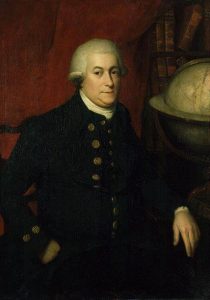 Captain George Vancouver, a British Officer, commanded the HMS Discovery and its accompanying ships on an exploratory voyage of the Pacific Northwest, between the years of 1791 and 1794. Vancouver and his crew were privileged to be the first to see places like Mount Saint Helens and the first to explore the Puget Sound. Their goal was to explore every bay and outlet in the region…following the coasts of Oregon and Washington. Men were sent in smaller boats to explore the Columbia River and enter the strait of Juan de Fuca.
Captain George Vancouver, a British Officer, commanded the HMS Discovery and its accompanying ships on an exploratory voyage of the Pacific Northwest, between the years of 1791 and 1794. Vancouver and his crew were privileged to be the first to see places like Mount Saint Helens and the first to explore the Puget Sound. Their goal was to explore every bay and outlet in the region…following the coasts of Oregon and Washington. Men were sent in smaller boats to explore the Columbia River and enter the strait of Juan de Fuca.
The larger ships, including the Chatham…the Armed Tender of the HMS Discovery, often anchored in the safe harbors, while the smaller vessels explored the many channels and rivers along the coast. On April 29, 1792, the ships entered the Straits of Juan de Fuca and anchored in the calm waters of Discovery Bay. While the ships stayed in the bay…using it as a base, Vancouver and his men explored the waters of Admiralty Inlet and Hood Canal. After several weeks of exploring, the Chatham began to sail north across the Straits of Juan de Fuca to explore the San Juan and Lopez Islands. After successfully exploring the islands, the Chatham sailed southward in May to rejoin the HMS Discovery and continue their explorations south. They moved the explorations south, as far as Commencement Bay in Tacoma, before turning around and returning north, where they hoped that the waters were going to be safer.
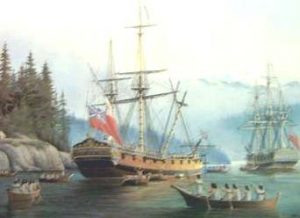 When the ships arrived at the Puget Sound, a storm was raging, accompanied by severe currents and tides. While crossing an unknown channel, the Chatham was caught by a flood tide and swept away helpless. In an effort to slow her progress, the crew dropped her stream anchor. Unfortunately, the strain was too much and the cable snapped. Amazingly, the Chatham survived, but the sweep of the waters did not locate the lost anchor, so the ship rejoined the HMS Discovery.
When the ships arrived at the Puget Sound, a storm was raging, accompanied by severe currents and tides. While crossing an unknown channel, the Chatham was caught by a flood tide and swept away helpless. In an effort to slow her progress, the crew dropped her stream anchor. Unfortunately, the strain was too much and the cable snapped. Amazingly, the Chatham survived, but the sweep of the waters did not locate the lost anchor, so the ship rejoined the HMS Discovery.
Vancouver’s journal entry for June 9, 1792 read, “We found tides here extremely rapid, and on the 9th in endeavoring to get around a point to the Bellingham Bay we were swept leeward of it with great impetuosity. We let go the anchor in 20 fathoms but in bringing it up such was the force of the tide that we parted the cable. At slack water we swept for the anchor but could not get it. After several fruitless attempts, we were at last obliged to leave it.”
These days, the anchor would be a treasure of great value, which motivated a company called Anchor Ventures, 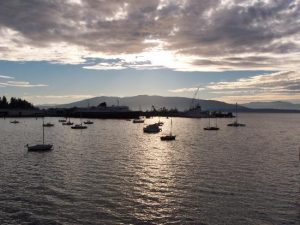 LLC of Seattle to initiate a search of not the Cannel, but rather off Whidbey Island’s northwestern shore. Their bet that the Chatham wasn’t with the Discovery at the time of the storm apparently paid off. Anchor Ventures pulled up what they believe to be the long lost anchor in 2014. Since then, the team has been trying to prove its identity. Skeptics aren’t so sure that this is the right anchor, because they say it is heavier than those of the late 1700s. That said, the question remains. Is the anchor still there, or did they jump to conclusions. It’s hard to say, and proof will be tough to find. I think it is not likely that they found the right anchor…especially looking in the wrong place.
LLC of Seattle to initiate a search of not the Cannel, but rather off Whidbey Island’s northwestern shore. Their bet that the Chatham wasn’t with the Discovery at the time of the storm apparently paid off. Anchor Ventures pulled up what they believe to be the long lost anchor in 2014. Since then, the team has been trying to prove its identity. Skeptics aren’t so sure that this is the right anchor, because they say it is heavier than those of the late 1700s. That said, the question remains. Is the anchor still there, or did they jump to conclusions. It’s hard to say, and proof will be tough to find. I think it is not likely that they found the right anchor…especially looking in the wrong place.
 My great grand niece, Izabella Siara Harman is quite a girl. She is the middle of her parents, Jake and Melanie Harman’s children, and quite the feisty one. Her grandmother, my niece, Chantel Balcerzak says she got her sassy attitude from her. Maybe that’s so, but Belle, as she is often called wears her sassiness well, and I think she is a total sweetie. If it’s possible, she wears her sassiness well.
My great grand niece, Izabella Siara Harman is quite a girl. She is the middle of her parents, Jake and Melanie Harman’s children, and quite the feisty one. Her grandmother, my niece, Chantel Balcerzak says she got her sassy attitude from her. Maybe that’s so, but Belle, as she is often called wears her sassiness well, and I think she is a total sweetie. If it’s possible, she wears her sassiness well.
Being just three years old, Belle is very curious about many things. She is still discovering the world around her, but she is beginning to be very aware of the things she likes and the things she doesn’t. She is developing her own personal style, and this girl is a girly girl. One of the things little Belle absolutely loves is lip balm…any version…tinted or just chapstick. I can’t blame her. I like the feel of lip balm too,so I can see why she would. Plus, I’m sure it makes her feel pretty.
Another thing that Belle has discovered and really has become pretty obsessed with is pockets. She wants pockets on her clothes, and she likes them on other people’s clothes. It could be because she knows that there are often cool things in those pockets, especially lip balm, or she likes being able to keep her own treasures in her pockets. Its funny what things kids decide that they really like. Well, this Belle’s things are lip balm and pockets.
 The other day, Belle wanted her dad’s chap stick, so he took it out of his pocket and gave it to her. Belle put some chap stick on, and after putting the lid back on, Belle promptly tucked it into the only pocket she had…or thought she had…her pull-up. She used it just like it was a pocket. After the moment of shock, her dad laughed and said, “Well that’s one chap stick I won’t be using again!!” Hahahahaha!! I don’t suppose he would either. What a goofy girl she is. I guess in the future, her parents are going to have to make sure that every outfit has a pocket, just in case she borrows a chap stick again.
The other day, Belle wanted her dad’s chap stick, so he took it out of his pocket and gave it to her. Belle put some chap stick on, and after putting the lid back on, Belle promptly tucked it into the only pocket she had…or thought she had…her pull-up. She used it just like it was a pocket. After the moment of shock, her dad laughed and said, “Well that’s one chap stick I won’t be using again!!” Hahahahaha!! I don’t suppose he would either. What a goofy girl she is. I guess in the future, her parents are going to have to make sure that every outfit has a pocket, just in case she borrows a chap stick again.
Well, little Belle will probably get over the lip balm and pocket stage at some point, but I seriously doubt if she will ever get over being the little cutie she is, because that is totally impossible. I love the excitement she shows every time I see her and her siblings. She always makes me smile. Today is Belle’s 3rd birthday. Happy birthday Belle!! Have a great day!! We love you!!
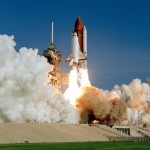 September 17, 1976 was an epic day in American history, and truly in world history as well. This was the day that the seemingly impossible became possible. Man had been in space many times by that date, but the crafts taken were disposable, and the cost to build new ones was great. It would be an amazing thing to have a craft that could take man into space, and then make a smooth landing back on Earth. It was unheard of, but it was no longer impossible.
September 17, 1976 was an epic day in American history, and truly in world history as well. This was the day that the seemingly impossible became possible. Man had been in space many times by that date, but the crafts taken were disposable, and the cost to build new ones was great. It would be an amazing thing to have a craft that could take man into space, and then make a smooth landing back on Earth. It was unheard of, but it was no longer impossible.
On this day in 1976, NASA publicly unveiled its first space shuttle. The shuttle was called Enterprise, and during a ceremony in Palmdale, California, the world got its first glimpse of the future. The Space Shuttle looked like an airplane. Its development cost almost $10 billion and took nearly a decade. The shuttle would not actually fly until 1977. Enterprise became the first space shuttle to fly freely when it was lifted to a height of 25,000 feet by a Boeing 747 airplane and then released, gliding back to Edwards Air Force Base on its own accord. It was a phenomenal accomplishment. What an exciting event in NASA history!!
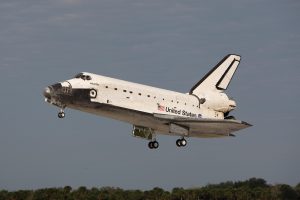
With the success of the first flight, came regular flights of the space shuttle, which began on April 12, 1981, with the launching of Columbia from Cape Canaveral, Florida. The shuttle had to be able to get into space, and so it was launched by two solid-rocket boosters and an external tank. These were ejected prior to the actual entrance into space, and only the shuttle, which looked like an actual airplane, entered into orbit around Earth. When the two-day mission was completed, the shuttle fired its engines to reduce speed and, after descending through the atmosphere, landed like a glider at California’s Air Force Base…brought to a stop with the help of three parachutes.
Early shuttles took satellite equipment into space and carried out various scientific experiments. On January 28, 1986, NASA and the space shuttle program suffered a major setback when the Challenger exploded 74 seconds after takeoff and all seven people aboard were killed. That was a horrible day in shuttle history. After changing the things that caused the problem, the shuttle flew again beginning in September 1988, when Discovery went up successfully. Since 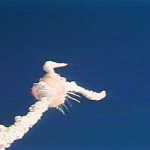 then, the space shuttle has carried out numerous important missions, such as the repair and maintenance of the Hubble Space Telescope and the construction and manning of the International Space Station. A tragedy in space again rocked the nation on February 1, 2003, when Columbia, on its 28th mission, disintegrated during re-entry of the earth’s atmosphere. All seven astronauts aboard were killed. In the aftermath, the space-shuttle program was grounded until Discovery returned to space in July 2005, amid concerns that the problems that had downed Columbia had not yet been fully solved. On July 21, 2011, Space Shuttle Atlantis touched down for the final time, at the end of STS-135, with the official retirement of NASA’s Space Shuttle fleet taking place from March to July 2011.
then, the space shuttle has carried out numerous important missions, such as the repair and maintenance of the Hubble Space Telescope and the construction and manning of the International Space Station. A tragedy in space again rocked the nation on February 1, 2003, when Columbia, on its 28th mission, disintegrated during re-entry of the earth’s atmosphere. All seven astronauts aboard were killed. In the aftermath, the space-shuttle program was grounded until Discovery returned to space in July 2005, amid concerns that the problems that had downed Columbia had not yet been fully solved. On July 21, 2011, Space Shuttle Atlantis touched down for the final time, at the end of STS-135, with the official retirement of NASA’s Space Shuttle fleet taking place from March to July 2011.
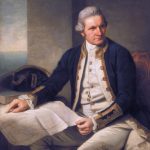 While visiting Alaska a few years ago, Bob and I kept hearing about Captain James Cook. I suppose I had probably heard a little about him at one point or another during my school years, but as often happens with kids, I wasn’t really interested…at least not until I saw Alaska for myself. Then, the places that were discussed in history actually came to life, because I was there in person. In reality, Captain Cook had a direct impact on several areas of the west coast of the United States, including the Puget Sound in Washington and areas of Oregon. Cook’s two ships, the Discovery and Resolution, had worked their way northwest from what is now Oregon and Puget Sound, along the British Columbia and Alaska coast, hoping to find the long sought after Northwest Passage to Europe.
While visiting Alaska a few years ago, Bob and I kept hearing about Captain James Cook. I suppose I had probably heard a little about him at one point or another during my school years, but as often happens with kids, I wasn’t really interested…at least not until I saw Alaska for myself. Then, the places that were discussed in history actually came to life, because I was there in person. In reality, Captain Cook had a direct impact on several areas of the west coast of the United States, including the Puget Sound in Washington and areas of Oregon. Cook’s two ships, the Discovery and Resolution, had worked their way northwest from what is now Oregon and Puget Sound, along the British Columbia and Alaska coast, hoping to find the long sought after Northwest Passage to Europe.
In early June 1778, Captain Cook and his men were in the Cook Inlet, hoping it would lead to the imagined passageway to Europe. It didn’t, of course, but once again Cook sent his crew exploring in small boats. Their adventures there led to the naming of Turnagain Arm, which Captain Cook originally called River Turnagain. It was so named because it was a disappointing “turn again” for Cook’s crew. The problem they were having was because Turnagain is subject to climate extremes and large tide ranges. During high tide, taking a boat in is simple, but if you don’t get out before low tide, you will find yourself fighting the quicksand-like mudflats that make up the beaches along Turnagain Arm in low tide.
In the times that Captain Cook was exploring for England, it was customary to name places after places and people in England. The visit to Cook Inlet was part of Cook’s longer exploration of the Alaska coast from which included a stop in Prince William Sound, which Cook named, along with Bligh Reef in the Sound. Bligh Reef would become famous in 1989 when the tanker Exxon Valdez ran aground on it and spilled millions of gallons of crude oil. Prince William Sound, interestingly, was almost named “Sandwich Sound” by Cook after the Earl of 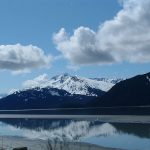 Sandwich in England, and who also, by the way, invented the sandwich as a food item. The Sound was renamed by Cook after Prince William, a descendent of the royal family when his journal was published. Leaving Prince William Sound, Cook ventured west along the Alaska coast to explore further, and after leaving Cook Inlet, he named Bristol Bay after Admiral Earl of Bristol, and Norton Sound after Sir Fletcher Norton, then Speaker of the British House of Commons. As he continued his quest for the Northwest Passage, Cook entered the Chukchi Sea through the Bering Strait and, amazingly, got as far as Icy Cape, on Alaska’s northwest coast, before being stopped by ice. In fact, the two ships were almost trapped by ice the off of Icy Cape.
Sandwich in England, and who also, by the way, invented the sandwich as a food item. The Sound was renamed by Cook after Prince William, a descendent of the royal family when his journal was published. Leaving Prince William Sound, Cook ventured west along the Alaska coast to explore further, and after leaving Cook Inlet, he named Bristol Bay after Admiral Earl of Bristol, and Norton Sound after Sir Fletcher Norton, then Speaker of the British House of Commons. As he continued his quest for the Northwest Passage, Cook entered the Chukchi Sea through the Bering Strait and, amazingly, got as far as Icy Cape, on Alaska’s northwest coast, before being stopped by ice. In fact, the two ships were almost trapped by ice the off of Icy Cape.
During his travels, Captain Cook named many other places, including Mount Edgecumbe and Cape Edgecumbe after George, Earl of Edgecumbe. He broke from protocol in naming Mount Fairweather and Cape Fairweather, using the fact that he had good weather at the time of his exploration, as inspiration for the names. Cross Sound was so named because he found it on May 3, designated on his calendar as Holy Cross day. Cape Suckling was named after Maurice Suckling, comptroller of the Royal Navy when Cook left England. Controller Bay was probably also named after Maurice Suckling, but the Russians translated the name to Zal Kontrolyer on the Hydrogaphy Department Chart 1378, dated 1847, and so it remained Controller Bay. Cape Hinchinbrook was named after Viscount Hinchinbroke. Snug Corner Cove was so named because Captain Cook thought, “And a very snug cove it is.” Montague Island was named after John Montagu, Earl of Sandwiche, the son of Viscount Hinchinbroke. The list of names and their origins goes on and on, but I find these the most interesting.
During his third visit to the Sandwiche Islands, which we now know as Hawaii, Captain James Cook lost his life  in a mob fight with the Hawaiian natives, who wanted one of his boats. As the men came ashore, the Hawaiians greeted Cook and his men by hurling rocks at them. They then stole a small cutter vessel from the Discovery. Negotiations with King Kalaniopuu for the return of the cutter collapsed after a lesser Hawaiian chief was shot to death, and a mob of Hawaiians descended on Cook’s party. The captain and his men fired on the angry Hawaiians, but they were outnumbered. Only a few managed to escape to the safety of the Resolution. Captain Cook was killed by the mob on February 14, 1779. A few days later, the Englishmen retaliated by firing their cannons and muskets at the shore, killing some 30 Hawaiians. The Resolution and Discovery eventually returned to England.
in a mob fight with the Hawaiian natives, who wanted one of his boats. As the men came ashore, the Hawaiians greeted Cook and his men by hurling rocks at them. They then stole a small cutter vessel from the Discovery. Negotiations with King Kalaniopuu for the return of the cutter collapsed after a lesser Hawaiian chief was shot to death, and a mob of Hawaiians descended on Cook’s party. The captain and his men fired on the angry Hawaiians, but they were outnumbered. Only a few managed to escape to the safety of the Resolution. Captain Cook was killed by the mob on February 14, 1779. A few days later, the Englishmen retaliated by firing their cannons and muskets at the shore, killing some 30 Hawaiians. The Resolution and Discovery eventually returned to England.
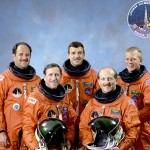 After a horrific accident such as Space Shuttle Challenger’s explosion 73 seconds after liftoff on January 28, 1986, taking with it seven astronauts, it is only prudent for NASA to have stopped all future flights until they knew the cause and had a fix in place. The Space Shuttle program was really NASA’s greatest achievement, and Challenger was its second shuttle into space. Challenger had a great record, having been sent into space nine times…before disaster struck on the tenth trip.
After a horrific accident such as Space Shuttle Challenger’s explosion 73 seconds after liftoff on January 28, 1986, taking with it seven astronauts, it is only prudent for NASA to have stopped all future flights until they knew the cause and had a fix in place. The Space Shuttle program was really NASA’s greatest achievement, and Challenger was its second shuttle into space. Challenger had a great record, having been sent into space nine times…before disaster struck on the tenth trip.
The Space Shuttle Challenger was first intended to be a test vehicle, Construction began in November of 1975. It was sent for testing on April 2, 1978, and after eleven months of vibration testing they decided to make it an actual vehicle. The first shuttle to be built into an actual workable unit was the Columbia, which ended up breaking up on February 1, 2003, to become the second time NASA lost lives in flight.
After Challenger blew up shortly after liftoff, NASA had to see what went wrong, and the space program was on hold for two years and eight months. Finally, after it was determined that an O-Ring failed due to weather that was too cold, a different NASA emerged. No longer would there be a rush to launch. Conditions would be right, or the launch would be scrubbed. It had to be that way. And yet we, as a nation, knew that America belonged in  space. This was more that just a whim, but was rather an important contribution in many areas. The scientists who went into space performed experiments that led to many things we use today. Not to mention all of the information we have learned about our own little part of the universe. It was time to put America back in space.
space. This was more that just a whim, but was rather an important contribution in many areas. The scientists who went into space performed experiments that led to many things we use today. Not to mention all of the information we have learned about our own little part of the universe. It was time to put America back in space.
So, on this day, September 29, 1988, NASA launched STS-26. It was the return to flight mission, and it was a success. The mission lasted four days, one hour, and eleven seconds, and traveled 1,680,000 miles, making 64 orbits around the Earth. The Shuttle that made the return to flight mission was the Discovery. On board were Frederick H Hauck, Richard O Covey, John M Lounge, Davis C Hilmers, and George D Nelson. I’m sure there were moments of anxiety, especially at the moment when the command to Go with Throttle Up, the very command that led to the explosion of the Challenger, was given. Nevertheless, these men went, and made it through that anxious moment, to have a successful mission. It was the first mission since STS-9 to use the original STS numbering system, the first to have all its crew members wear pressure suits for launch and landing since STS-4, and the first mission with bailout capacity since STS-4. STS-26 was also the first all-veteran crew mission since Apollo 11, with all of its crew members having flown at least one prior mission. I’m sure there were specific reason for each of those things, but my guess is that it was mainly to have all the best  possible precautions in place.
possible precautions in place.
Besides conducting the mission’s various experiments, crew members practiced suiting up in new partial-pressure “launch-and-entry” flight suits, and also practiced the unstowing and attaching of the new crew escape system. On 2 October, the day before the mission ended, the five man crew paid tribute to the seven crew members lost in the Challenger disaster. Discovery landed on Runway 17 at Edwards Air Force Base, California, at 12:37 pm EDT on 3 October 1988, after a mission duration of four days, one hour and eleven seconds. Capsule Communicator Blaine Hammond Jr welcomed the crew, saying it was “a great ending to a new beginning.”

